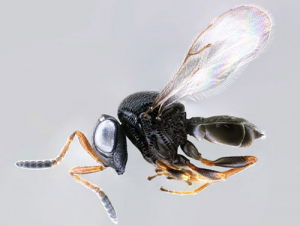And a speck-sized samurai wasp could well be the answer says a biosecurity expert.
New Zealand Winegrowers (NZW) is part of a horticulture and viticulture industry steering group that is partnering with the Ministry for Primary Industries (MPI) to explore the possibility of using Trissolcus japonicus, also known as the samurai wasp, as a biocontrol agent should BMSB make its way to New Zealand.
NZW Biosecurity Manager Dr Edwin Massey says the work is about being proactive when it comes to biosecurity, so that if BMSB gets to New Zealand shores, the industry is ready.
“We are not aiming to release the wasp should we get approval. What we are seeking is approval from the Environmental Protection Authority to import it into containment for potential release as a response tool to help counter BMSB.”
Massey says previous work conducted by Plant & Food Research (PFR), Better Border Biosecurity (B3), and their colleagues at the US Department of Agriculture (USDA), has identified that the samurai wasp parasitoid is an ideal biocontrol agent for BMSB. However, research and contained experiments are necessary to quantify the potential risks the samurai wasp could pose to other pentatomidae, the shield bug family BMSB belongs to, including a New Zealand native species. That species, the black alpine shield bug – Hypsithocus hudsonae (BAU) - lives in alpine areas in Central Otago, which means that it is unlikely to be encountered by grape growers and has been difficult for scientists to collect to commence “host testing”.
BMSB feeds off a wide range of plants and emits a long lasting, foul smelling odour when threatened, which can taint grape juice. The female samurai wasp - which is the size of a sesame seed - lays its eggs inside stinkbugs’ eggs and the developing larvae destroy the host as they eat their way out.
Massey says that could make it an important weapon in the “arsenal” against BMSB, because there are no dedicated surveillance and control traps for the pest, meaning a response would have to rely on people’s eyes and chemical controls if there was not a predator involved.
“Chemical control is not a particularly cost-effective control strategy. The good thing about parasitoids is they are like heat seeking missiles that hunt down the pest you want to target.”
With a natural predator on the ground, growers would need fewer pesticides in the battle against BMSB, retaining international market access for industries that rely on low pesticide residues, he says.
The New Zealand Institute of Economic Research (NZIER) is currently doing an analysis for the steering group, outlining the potential impact of a BMSB incursion on New Zealand horticulture/viticulture. It will model the costs of BMSB in both managed and unmitigated scenarios, and will help inform the application to bring the wasp into containment in New Zealand. The analysis measures the differences between what would occur under BAU and what would occur if this BAU was “shocked” such as through the establishment of BMSB as a major horticultural production pest. Draft results highlight that precautionary biocontrol is likely to significantly mitigate losses caused by the impact of BMSB across New Zealand horticulture/viticulture. Forecasting out over 20 years the model indicates that the Samurai wasp would mitigate losses to the wine industry caused by BMSB by approximately $335 million.
This illustrates just how much potential the Samurai wasp could have as a response tool.
The report is due out shortly, and Massey says time is of the essence.
“It’s important that we proceed as fast as we can to get ready for the next high risk season in September.”










